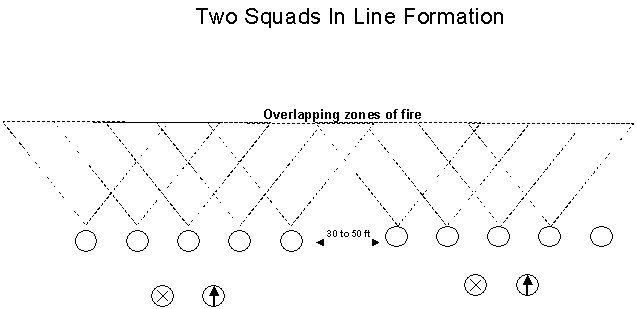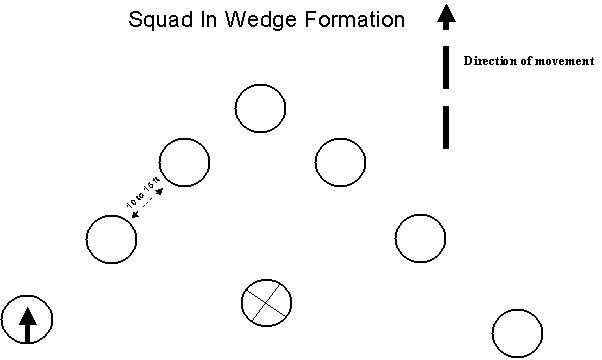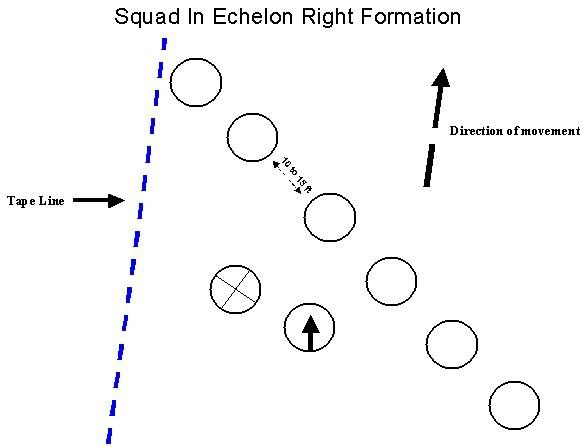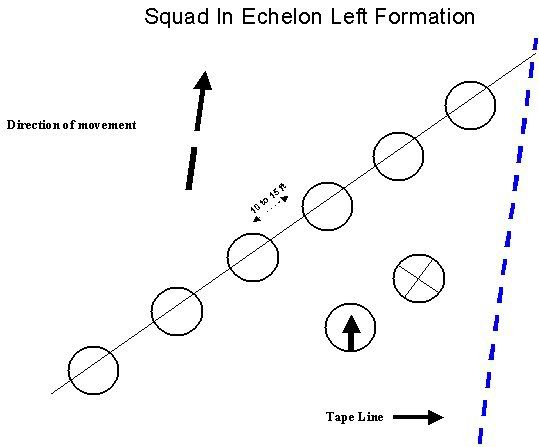Xman
Officier    Excutive Officier/S-3
Excutive Officier/S-3
Posts: 1,636
|
Post by Xman on Jan 16, 2008 13:24:59 GMT -5
The following are basic tactical formations for small units (fire teams and squads). Each formation should be employed based on the tactical situation. Note Squad Leaders are identified as a circle with an X. A circle with an arrow denotes a heavy gunner.
|
|
Xman
Officier    Excutive Officier/S-3
Excutive Officier/S-3
Posts: 1,636
|
Post by Xman on Jan 16, 2008 13:44:57 GMT -5
When to use: When opfor contact is imminent. Strength: Maximizes unit fire power to the front. Weakness: Difficult to control in closed, broken terrain. Not suitable for moving long distances. Individual Spacing: 10 to 15 feet based on terrain Unit Spacing: 30 to 50 feet based on terrain (units should be able to maintain visual contact and overlap fires.) In this formation the Squad Leader should remain in back of the line towards its middle so that they can control the unit while moving and during contact. They should al keep a heavy gunner with them so that they can reinforce any part of the line or direct covering fire. Also, note that each man has a fire zone they are responsible for which overlaps with the man next to them.  
|
|
Xman
Officier    Excutive Officier/S-3
Excutive Officier/S-3
Posts: 1,636
|
Post by Xman on Jan 16, 2008 14:01:35 GMT -5
When to use: While moving in a tactical situation where unit flanks are uncovered and the location of the enemy is not known. Strength: Easy to control, provides security to the front and sides. Very all good purpose formation when moving towards a known or suspected opposition location. Weakness: Lacks rear security. Individual Spacing: 10 to 15 feet based on terrain Unit Spacing: 30 to 50 feet based on terrain (units should be able to maintain visual contact and overlap fires.) The wedge expands and contracts depending on the terrain. The squad should modify the wedge when rough terrain, poor visibility, or other factors make control of the wedge difficult, the normal interval is reduced so that all squad members can still see their squad leader. The sides of the wedge can contract to the point where the wedge resembles a single file. Team members can expand or resume their original positions when moving in less rugged terrain where control is easier. 
|
|
Xman
Officier    Excutive Officier/S-3
Excutive Officier/S-3
Posts: 1,636
|
Post by Xman on Jan 16, 2008 15:46:51 GMT -5
When to use: One flank is covered by a terrain feature, tapeline, or another squad Strength: Easy to control, focuses security to the open flank. Used when moving towards a known or suspected opposition location. Weakness: Lacks rear security. Individual Spacing: 10 to 15 feet based on terrain Unit Spacing: 30 to 50 feet based on terrain (units should be able to maintain visual contact and overlap fires.) The echelon formation is best used when one flank is covered by a terrain feature that blocks the Opfor from approaching or firing on the squad. The terrain feature could be a wide body of water, base of a mountain or hill, or a tapeline.  
|
|
Xman
Officier    Excutive Officier/S-3
Excutive Officier/S-3
Posts: 1,636
|
Post by Xman on Jan 16, 2008 16:38:22 GMT -5
When to use: While moving in a tactical situation where unit flanks are uncovered and the location of the Opfor is not known. Opfor may attack from any direction Strength: Easy to control, All round (360 degree) security. Used when moving towards a known or suspected opposition location. Best all purpose formation when moving deep into Opfor territory. Weakness: None Individual Spacing: 10 to 15 feet based on terrain Unit Spacing: 30 to 50 feet based on terrain (units should be able to maintain visual contact and overlap fires.) In most cases the diamond formation can be substituted for the wedge formation. In cases where you know the likelihood of the Opfor being behind you is small the wedge will concentrate more firepower to the front of the squad. However, The diamond makes it less likely the squad can be surprised from the rear. 
|
|